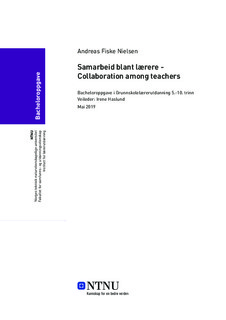| dc.contributor.advisor | Haslund, Irene | |
| dc.contributor.advisor | Andreassen, Øyvind Soltun | |
| dc.contributor.author | Nielsen, Andreas Fiske | |
| dc.date.accessioned | 2019-08-23T14:06:42Z | |
| dc.date.available | 2019-08-23T14:06:42Z | |
| dc.date.issued | 2019 | |
| dc.identifier.uri | http://hdl.handle.net/11250/2610211 | |
| dc.description.abstract | Denne oppgaven vil belyse problemstillingen Hvilke samarbeidskulturer finnes ved to ungdomsskoler i Trøndelag, og hvordan brukes samarbeid for å forebygge atferdsproblemer blant elever?
Oppgaven bygger på teori som handler om hvordan skolen er organisert for å legge til rette for samarbeid, hvordan samarbeid foregår i skolen og læreren som klasseleder for å forebygge atferdsproblemer hos elever.
Oppgaven benytter kvalitativt intervju og observasjon for å samle inn data. Det er fordelaktig å bruke begge metodene fordi man får se tydelig hva respondenter sier, og hva de faktisk gjør.
Funn som er gjort viser at lærere ofte kan beskrive et ideal når det gjelder samarbeid, men at dette ikke gjenspeiles i deres praksis. Oppgaven viser at organiseringen i skolen kan av flere grunner virke hemmende for samarbeid blant lærere. En mulighet for samarbeid ser ut til å ligge i det fysiske arbeidsmiljøet. Det finnes ulike måter å samarbeide på, her vil vi se nærmere på noen av de og drøfte fordeler og ulemper ved de ulike måtene man kan samarbeide på. Oppgaven viser også en relativt stor forskjell i skolekulturen ved to skoler som arbeider med elever i ungdomstrinnet. | |
| dc.description.abstract | This thesis will highlight the problem set What collaboration cultures are found at secondary schools in Trøndelag, and how collaboration is used to prevent behaviour problems among students?
This thesis builds on theories about how the school is organized to facilitate collaboration, how the actual collaboration takes place in school, and the teacher as a class leader to prevent behaviour problems with pupils.
The thesis uses qualitative interview and observation for collecting data. It is profitable using both methods because you can clearly see what the respondents says, and what they actually do. Findings show that teachers often can describe an ideal when it comes to collaboration, but that this does not reflect in their practice. The thesis shows that the organization in school can for several reasons inhibit collaboration among teachers. A opportunity for collaboration seems to be in the physical working environment. There are different ways of collaborating, here we will take a closer look at some of them and discuss advantages and disadvantages of the different ways of collaborating.
The thesis also show a relatively large difference in the school culture at the two schools working with pupils in the secondary school. | |
| dc.language | nob | |
| dc.publisher | NTNU | |
| dc.title | Samarbeid blant lærere | |
| dc.type | Bachelor thesis | |
